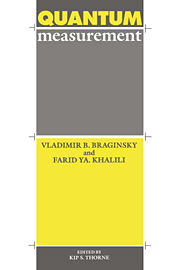Book contents
- Frontmatter
- Contents
- Dedication
- Editor's Foreword
- Notation
- Chapter I Historical introduction: photons and measurements using photons
- Chapter II The main principles of quantum mechanics
- Chapter III Indirect measurements
- Chapter IV Quantum nondemolition measurements
- Chapter V Linear measurements
- Chapter VI Continuous linear measurements
- Chapter VII Nonlinear systems for continuous measurements
- Chapter VIII Detection of classical forces
- Chapter IX Energetic quantum limitations
- Chapter X Devices for measuring small mechanical displacements
- Chapter XI Quantum nondemolition measurements of a resonator's energy
- Chapter XII Nonclassical states of electromagnetic waves as tools for quantum measurements
- Conclusion
- References
- Subject Index
Chapter VI - Continuous linear measurements
Published online by Cambridge University Press: 15 December 2009
- Frontmatter
- Contents
- Dedication
- Editor's Foreword
- Notation
- Chapter I Historical introduction: photons and measurements using photons
- Chapter II The main principles of quantum mechanics
- Chapter III Indirect measurements
- Chapter IV Quantum nondemolition measurements
- Chapter V Linear measurements
- Chapter VI Continuous linear measurements
- Chapter VII Nonlinear systems for continuous measurements
- Chapter VIII Detection of classical forces
- Chapter IX Energetic quantum limitations
- Chapter X Devices for measuring small mechanical displacements
- Chapter XI Quantum nondemolition measurements of a resonator's energy
- Chapter XII Nonclassical states of electromagnetic waves as tools for quantum measurements
- Conclusion
- References
- Subject Index
Summary
Discrete and continuous measurements
All the examples of measurements so far discussed have in common the fact that the experimental output is either a single number or a finite set of numbers. However, in real measurements the output is often a record of some continuous function of time, from which one can get an understanding of the behavior of the measured quantity during some time interval. This type of measurement is called continuous. Correspondingly, measurements that give a discrete set of numbers can be called discrete.
Let us note that measurements are sometimes called continuous if they are made not instantaneously, but over a finite duration of time. Evidently, this is not a reasonable viewpoint; all real measurements last for a finite time. The dividing line between continuous and discrete measurements is in fact the character of the output signal: does it give information about the measured quantity only at some chosen moment of time, or does it permit a continuous monitoring of the quantity's time evolution.
The necessity to develop the quantum theory of continuous measurements arose in the 1960s, when devices for making continuous measurements were developed with sensitivities close to the quantum level (masers, parametric amplifiers, optical heterodyne receivers, …).
Information
- Type
- Chapter
- Information
- Quantum Measurement , pp. 76 - 92Publisher: Cambridge University PressPrint publication year: 1992
Accessibility standard: Unknown
Why this information is here
This section outlines the accessibility features of this content - including support for screen readers, full keyboard navigation and high-contrast display options. This may not be relevant for you.Accessibility Information
- 1
- Cited by
